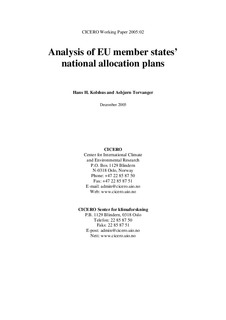| dc.contributor.author | Kolshus, Hans H. | nb_NO |
| dc.contributor.author | Torvanger, Asbjørn | nb_NO |
| dc.date.accessioned | 2014-03-17T14:31:21Z | |
| dc.date.available | 2014-03-17T14:31:21Z | |
| dc.date.issued | 2005 | nb_NO |
| dc.identifier.issn | 0504-452X | nb_NO |
| dc.identifier.uri | http://hdl.handle.net/11250/192300 | |
| dc.description.abstract | The European Union’s (EU) emissions trading scheme (ETS) started on 01 January 2005. The ETS covers CO2 emissions from large emitters in the power and heat generation industry and selected energy-intensive industrial sectors. The EU member states have developed national allocation plans (NAP) stating the total quantity of allowances and how they propose to allocate them. This study analyzes available NAPs to examine whether EU countries require less from its ETS sectors than its non-ETS sectors and whether some ETS sectors have been favored in the allocation. Allocations are compared against three reference points (projected emissions, historical emissions and a calculated Kyoto Protocol CO2 target). The NAP analysis indicates that the relative generous allocations are likely to result in minor steps towards meeting the countries’ commitments under the Kyoto Protocol. Available data indicates that sectors exposed to international competition have been favored in terms of allocations. Therefore, non-ETS sectors in many countries have to substantially reduce their emissions to meet the Kyoto targets unless JI and CDM are used extensively. | nb_NO |
| dc.language.iso | eng | nb_NO |
| dc.publisher | CICERO Center for International Climate and Environmental Research - Oslo | nb_NO |
| dc.relation.ispartof | CICERO Working Paper | nb_NO |
| dc.relation.ispartofseries | CICERO Working Paper;2005:02 | nb_NO |
| dc.title | Analysis of EU member states' national allocation plans | nb_NO |
| dc.type | Working paper | nb_NO |
| dc.source.pagenumber | 37 | nb_NO |
